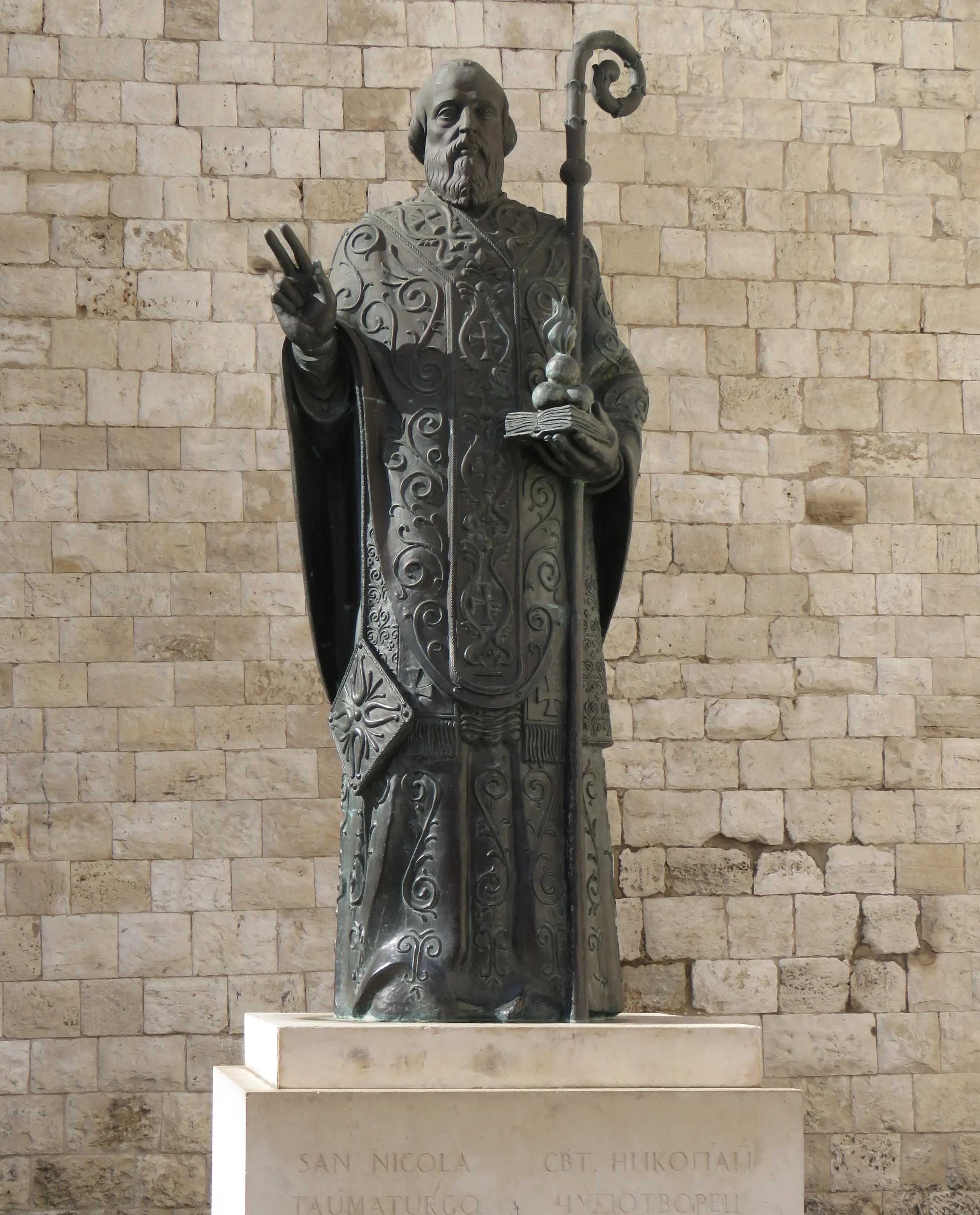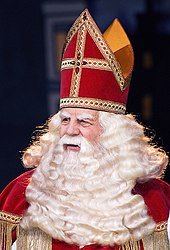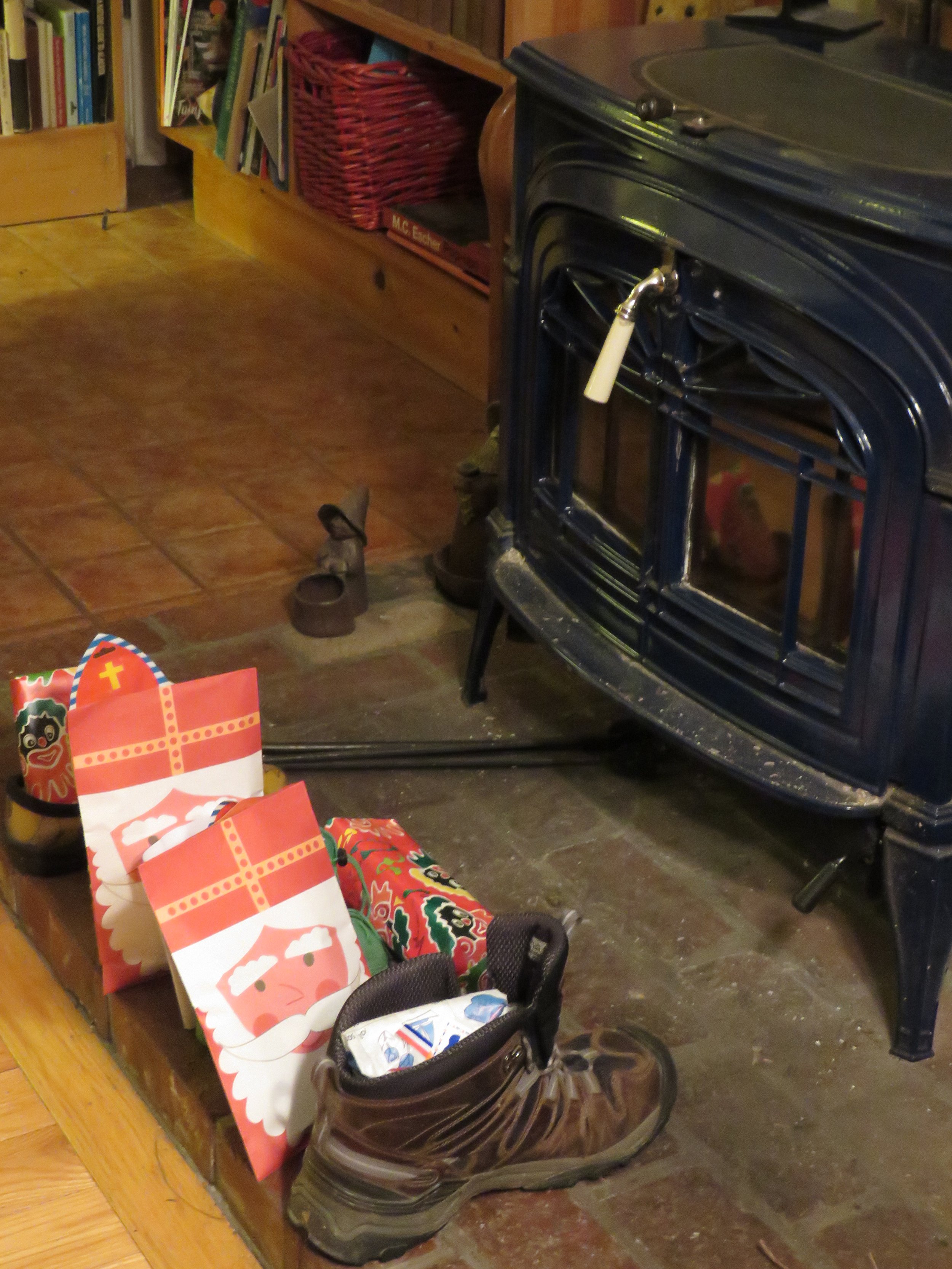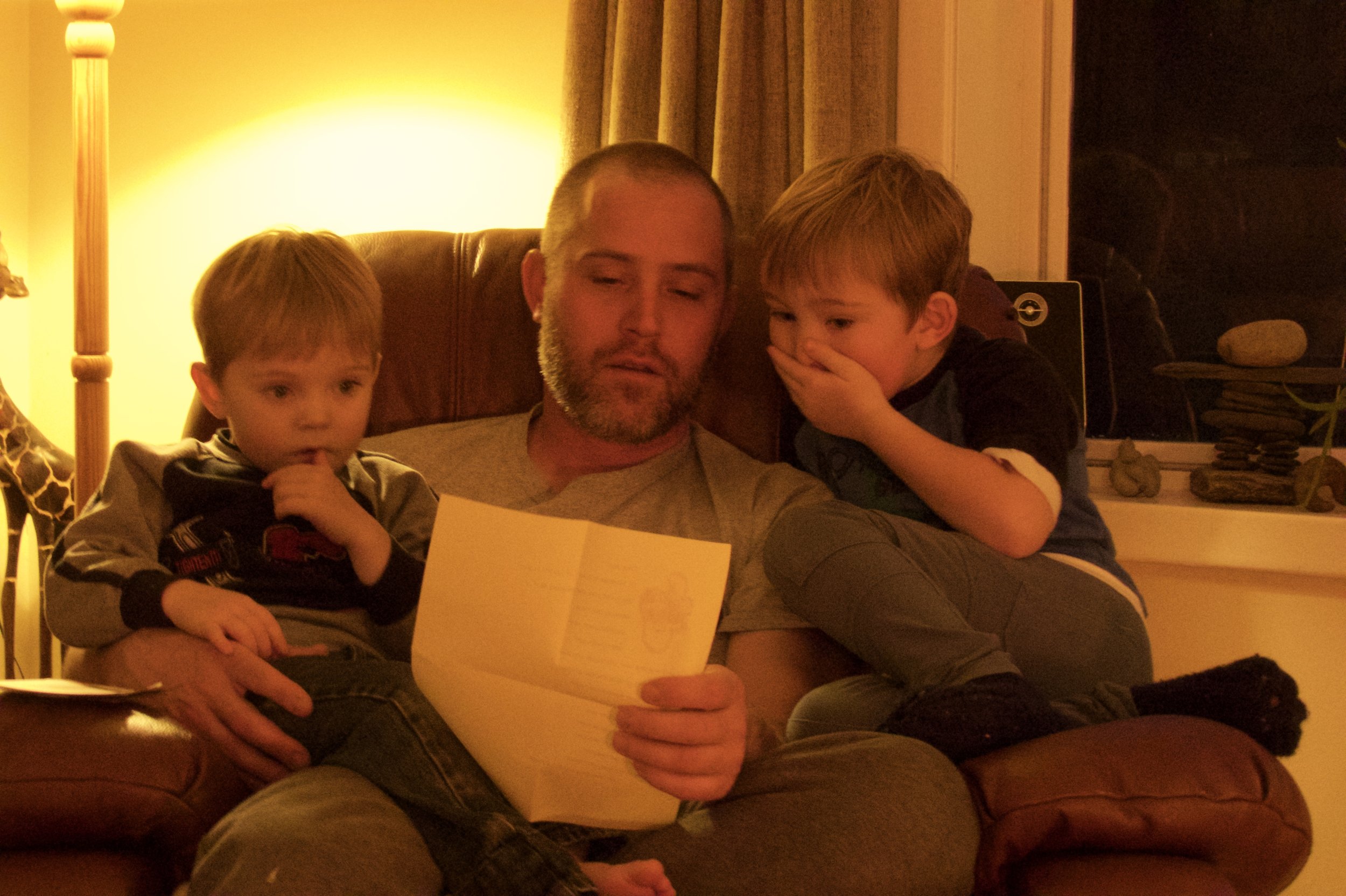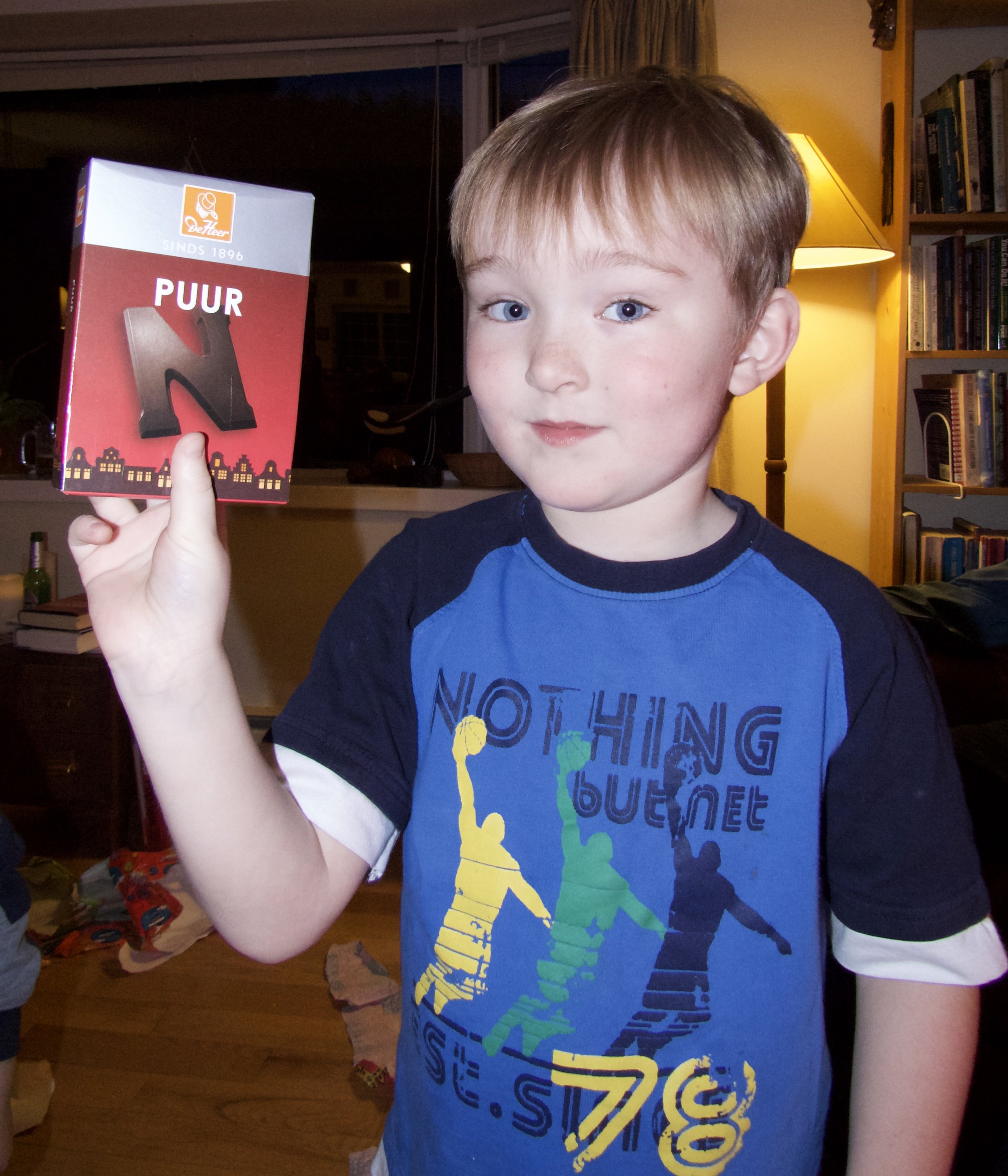This time a different story… Not so much our physical travels as a story of tradition and customs as it traveled around the world and through time. Because the weekend of this blog post is around St. Nicolaas Day, I’d like to share with you the story of how St. Nicolaas became Santa Claus, the origins of a celebration that traveled from Turkey to Spain, involved Africa, spread throughout Europe and to the new world…
Sometimes it is hard to know if a story is fictional or if it, or its roots, might be true. If the story is powerful enough it will live on and on, changing over time as people retell it to each other. Some stories are so powerful that no one, after hundreds of years, remembers if it actually happened or not.
My annual visit to St. Nicolaas, age three.
Sometimes you can find the roots of a story. Other times the roots are so spread out that it’s hard to know for sure whére and whén the story originated. This is the true story of Saint Nick, Saint Nicolas, Sinterklaas, Santa Claus - no matter how you spell his name.
Remember how, as a child, you tiptoed downstairs in your p.j.’s to discovered if Santa really had come? Or the night before, when you were determined to hear his footsteps on the roof. . Then, as you got older, someone told you that Santa didn’t exist. Well, I have good news. Santa really did exist. He was a real person and all of the wonderful things that we associate with Santa have a reason. He may no longer be alive, but his spirit lives on. So, come along as we explore the origins of Santa Claus!
“Once upon a time… some say it was in the year 245 A.D., others say it was about a hundred years later in the year 365 - a boy named Nicolas was born in a far away country. He lived in Patara in southern Turkey or perhaps, as some researchers say, in the city of Myra in Western Turkey. But we do know that it was in Turkey.
Nicolas was the son of a wealthy merchant. He was a kind boy who had everything he could wish for. But his friends were mostly children of poor peasants. So on his birthday, Nicolas gave gifts instead of receiving them.
Once, or so the story goes, he heard about a poor father who needed a dowry for his three daughters. Nicolas went by their cottage at night and threw a purse full of gold coins inside, thus helping the father to send off his daughters on a good life of their own.
When Nicolas was young, he received a good education and traveled to Palestine and Egypt. He joined the Catholic Church and became the youngest bishop in its history. His name was now Nicolas, Bishop of Mira.
Like many other Christians of that era, he was put in prison for his beliefs when the Roman emperor Diocletian was in power. But Nicolas was released when the new ruler, Constantine the Great, announced that the Christian Church would be the official religion.
After Nicolas died, he was buried in Demre, Turkey and a church was built there in his memory. About six hundred years later, Italian pirates stole some of his bones and took them to Bari in southern Italy, a bustling harbor town during the Middle Ages. In their haste they left a few bones behind which are now on display in the Antalya Museum in Turkey (Türkiye).
So just as we are not exactly sure where he was born, we can’t be exactly sure where Nicolas’s remains were buried. Is it in Demre? Or in Bari? The city of Venice, Italy also claims to have the bones of the saint. But the true relics of St. Nicholas are said to be in the basilica of St. Nicola, in Bari, Italy.
We visited the St. Nicola Basilica in Bari, Italy
About two hundred years after his death, a Roman Emperor built a church in honour of St. Nicholas in Constantinople, Greece. During the Middle Ages, stories of St. Nicolas’ fame spread rapidly and thousands of churches are now dedicated to him. In England alone, more than four hundred churches are dedicated to Nicholas.
He has been declared the patron saint of Russia, Moscow, Greece, children, sailors, prisoners, bakers, pawnbrokers, shopkeepers and even wolves! Greek and Russian sailors ask St. Nicolas for protection and always carry an image of the saint in the cabin of their ships.
The image of St. Nicolaas as protector of children and sailors, was likely brought to The Netherlands during the Spanish occupation (1516-1609) when Dutch sailors met catholic Spanish sailors on their travels. Saint Nicholas protected their vessels and trade. After the 80 year Spanish occupation of The Netherlands, the Spanish left but the spirit of Saint Nicholas stayed.
By the 17th century St. Nicolaas Day was being celebrated throughout Europe. December 6 is believed to be either St. Nicolaas’s birthday or the anniversary of his death. It is now a widespread tradition that gifts are delivered to children on the eve of this day. In Germany, the day is celebrated on December 6, in Holland December 5 is St. Nicolaas day. St. Nicolas was known as Sankt Nikolaus in Germany. During the 17th century, German Protestants started to encourage the worship of the Christkindl (Christ child) as a gift giver on his own special day: December 25. And so, in some countries, the gift giving tradition of St. Nicolas became attached to Christmas time.
The name Christkindl slowly changed into Kriss Kringle, yet another, albeit eronous, name for St. Nicolaas. Sint Nicolaas in The Netherlands still wears the traditional red robes of a Catholic bishop. In Austria, the bishop is called Knecht Ruprecht or Krampus. Various other European Christmas gift givers include:
France: Père Noël
England: Father Christmas
Scandinavia: Julenisse
Finland: Joulupukki
Germany: Sankt Nikolaus
The Netherlands: St. Nicolaas or Sinterklaas
North America: Santa Claus or Saint Nick
In The Netherlands, myth has it that St. Nicolaas lives in Madrid, Spain. This could explain why St. Nicholaas has "zwarte pieten", or Black Peters, as helpers. The Moors of North Africa dominated Spain for several hundreds of years. All things evolve and change with time. The customs of having black helpers is now very much frowned upon, even banned, in The Netherlands. Black Peters now have faces painted half white, half black.
In Holland St. Nicolaas, or Sinterklaas as the Dutch often call him, makes his entrance into the country a couple of weeks before his December 6 birthday. According to legend, he arrives by boat from Madrid, Spain where he lives. Almost every city in Holland has an official arrival of St. Nicolaas, which takes place by boat in the harbour and is followed by a parade through the city with St. Nicolaas riding his white horse and followed on foot by his helpers who carry bulging bags of gifts and goodies. Thousands of children, and their parents, line the route and to wave, hoping he will visit their house soon!
Again according to legend, St. Nicolaas visits children by riding his white horse on the roof tops. Peter listens and looks down the chimney to make sure that the children in that house were good all year. He reports on their behavior to the Saint who writes notes in his big book. Before bedtime, children sing Sinterklaas songs and place their shoe by the chimney. They put a slice of bread and some hay or a carrot in the shoe to feed the horse of St. Nicolaas. You better hope you behaved well otherwise you just might find a ‘roo’, a bundle of twigs, in your shoe!
If you were good, though, chances are that you will find a tiny gift, cookies or chocolate in your shoe the next morning. And, of course, the food for the horse has disappeared! In other countries, shoes were replaced by stockings.
Then on the eve of December 5, St. Nicolaas Day, St. Nicolaas brings gifts to each and every house. The anticipation has been building all day and, when it gets dusk, there might be a sudden pounding on the front door. When children rush to open the door, no one is there but a bulging burlap bag full of gifts waiting to be hauled inside!
When I was little I once got a hollowed out carrot with a gift hidden inside.
It is tradition, in The Netherlands, to not just exchange gifts by wrapping them up! For every person you give a gift to, you have to think of something to tease them about. Then you ‘build’ a surprise - you wrap up the gift in a ‘disguise’. And you have to write a long poem, teasing the receiver and having good, clean fun. For instance, if you really like reading and writing, and I wanted to give you a new book, I might build you a large cardboard ‘book’ and give it a funny title, with your name on it as the author. Inside the cardboard book I would hide your gift. The accompanying poem would tease you with all the books you read all year, how you neglect to do work because you read so much, etc. The poem would then instruct you to open the book and look for your gift. This is why the evening of gift giving takes a long time - everyone takes turns reading out loud their poems and showing their ‘surprises’. When I was in highschool my teachers paid me to write poems for their family members…
Reading a St. Nicolaas poem together..
St. Nick brings your chocolate initial in Holland.
During this whole process, Saint Nicolaas turned into a world traveler. He was brought to New York (first called New Amsterdam!) in the 17th century by Dutch settlers. They introduced their traditional celebration to North America while settling the Hudson Valley between 1614 and 1674, where St. Nicolaas was in turn adopted by the British Colonists.
The very first time St. Nicolaas is mentioned in the American Press is in 1773 as ‘St. A. Claus’. In 1804 the New York Historical Society was founded with St. Nicholas as its patron saint. Its members revived the Dutch tradition of St. Nicholas as a gift giver.
In 1809, the American author Washington Irving was the first to describe the Dutch version of Saint Nicholas in North America. He was a member of the New York Historical Society and it was here that he saw a wooden cut-out of the Saint, wearing long robes. The author also heard a Dutch rhyme about Sinterklaas. In 1812 Mr. Irving wrote about Nicholas riding over the tops of trees and bringing gifts to children.
A few years later, in 1821, a New York printer named William Gilley published a poem in which he wrote about ‘Santeclaus’ (can you see the name ‘Sinterklaas’ in there?) all dressed in fur and driving a sleigh.
Then, in 1823, Clement Clarke Moore wrote his famous poem ‘A Visit From St. Nicholas’, now better known by its first line: ‘t Was the Night Before Christmas’, making Saint Nick, or Santa Claus, an official American figure. Ever since then, Santa Claus has been the traditional bringer of gifts at Christmas time in North America, wearing a red suit and a white beard.
During the transition from Europe to North America, St. Nicolaas became Santa Claus. His appearance changed from a tall, sober, quiet and fairly strict man. It mingled with the tradition of the Christ Child bringing gifts and others and... voilá... Santa Claus became jolly and fat like an elf, even carrying his own bag. His long red robe changed to a a red suit trimmed with white fur. But his long white beard and his love of children remained the same.
By 1863, an illustrator named Thomas Nast created an image for Santa Claus drawing him as a merry old elf and dressed in fur. In 1885 the first Christmas cards were made in North America, featuring a chubby Santa in a red suit.
Then, in the 1930’s, the Coca Cola company was looking for way to promote their product in winter. They hired an illustrator named Haddon Sundblom who created pictures of a jolly Santa dressed in red-and-white and drinking coca cola! That image helped to establish the figure of American Santa Claus for ever!
Pretty soon children wanted to know where Santa lives when he is not delivering gifts. It was in 1925 that a radio announcer in Finland announced to the world that Santa actually lives at the North Pole all year! He lives in a town called Korvatunturi in Lapland and it is there that his reindeer graze.
The Evolution of St. Nicolas to Santa Claus:
• St. Nicolaas changed to Santa Claus:
• His transportation changed
from a white horse on roof tops to reindeer and a sleigh
• His helpers changed
from Black Peter to elves
• shoes left by the chimney changed to stockings to receive gifts
Our little helper dressed as Peter
And so, does Santa Claus really exist? He certainly did once. And his spirit lives on throughout the ages. If yóu believe in sharing and joy and giving gifts to others, then Santa Claus, or Sinterklaas or Saint Nicolaas or whatever else you might call him, certainly does exist. Happy St. Nicolaas day.
https://magazine.columbia.edu/article/story-behind-most-famous-christmas-poem-all
